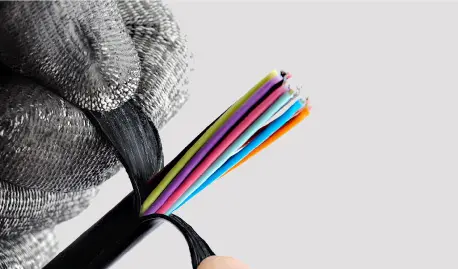Fiber color code is a standard specification for color coding of fiber optic cables, developed by the Telecommunications Industry Association (TIA). EIA/TIA-598 is a globally recognized fiber optic color coding standard that specifies the outer jacket of fiber optic patch cords, fiber optic connectors, and optical fiber colors to help better identify, install, and maintain different types of fiber optic cables, thereby improving the reliability and efficiency of the entire fiber optic cabling system.

Outer Jacket Color Code
Due to the different types of fibers and application environments of fiber patch cords, their outer jackets are usually distinguished by specific colors. In EIA/TIA-598, the outer jacket color of different optical fibers for non military applications is defined. Single mode fibers use yellow outer jacket, while multimode optical fibers use orange, aqua, violet, lime green to help quickly identify different types of multimode fibers.
In addition to color differentiation, manufacturers will print information on fiber optic jumpers, usually including fiber type and specifications. Therefore, in practical applications, it is best to combine color and label information to determine the fiber optic type.

Fiber Connector Color Code
Fiber connectors in fiber optic cabling systems also follow a color coding system for identification, which allows for quick differentiation and identification of different types of fiber optic connectors. This is particularly important in complex installations involving numerous connections, reducing the possibility of errors and ensuring accurate connection of fiber optic networks.
Standard OM1 connector is usually beige or grey, OM2 is black, OM3 is aqua, OM4 is violet, while OM5 is lime green. It is worth noting that if the single-mode connector is UPC, it is blue, and if it is APC, it is green.

Optical Fiber Color Code
Inside the fiber optic patch cords, each optical fiber is color coded, usually in groups of 12 fibers, and counted clockwise. If there are more than 12 fiber cores, the previous 12 colors will be repeated, but with other colored markings. This encoding method can help quickly manage and maintain fiber optic links, which is crucial for maintaining signal continuity and efficiency.

Function of Fiber Color Code
Easy to install
By encoding different fiber colors, it is possible to quickly distinguish between fiber cable types and connector types, which is beneficial for installation and improves work efficiency.
Easy to manage
Fiber optic color coding system helps to standardize the management of fiber optic cabling systems and avoid optical communication link failures caused by human error.
Easy to maintain
Different colored optical fibers and connectors can assist maintenance personnel in quickly locating and troubleshooting problems, reducing downtime.
Reliable stability
Fiber optic color code provides a unified color coding system, effectively preventing misconnections and helping to ensure long-term stable and reliable operation of fiber optic links.

